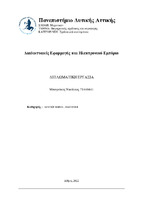| dc.contributor.advisor | Leligou, Helen C. (Nelly) | |
| dc.contributor.author | Μπογράκος, Νικόλαος | |
| dc.date.accessioned | 2022-08-01T06:54:05Z | |
| dc.date.available | 2022-08-01T06:54:05Z | |
| dc.date.issued | 2022-07-14 | |
| dc.identifier.uri | https://polynoe.lib.uniwa.gr/xmlui/handle/11400/2734 | |
| dc.identifier.uri | http://dx.doi.org/10.26265/polynoe-2574 | |
| dc.description.abstract | Η διπλωματική εργασία αναφέρεται, στις διαδικτυακές εφαρμογές και στο ηλεκτρονικό εμπόριο. Αρχικά εξηγεί την έννοια του ηλεκτρονικού εμπορίου και το χωρίζει σε έξι βασικά χαρακτηριστικά, ενώ στην συνέχεια αναφέρεται στις νέες τεχνολογίες του. Το πρώτο από τα έξι βασικά χαρακτηριστικά είναι η ανάπτυξη προϊόντων, στην οποία περιέχονται η ιδέα για το προγονή σχεδίαση, η κατασκευή, η παρουσίαση στο κοινό και τελικά η ανατροφοδότηση και η βελτίωση. Το δεύτερο χαρακτηριστικό είναι η πώληση προϊόντων, στην οποία ο πωλητής θα πρέπει να ξεχωρίσει το κοινό στο οποίο απευθύνεται. Τρίτο είναι παράδοση προϊόντων και το κόστος των μεταφορικών. Το τέταρτο χαρακτηριστικό απαρτίζεται από την προώθηση προϊόντων, όπου διαφορετικό κοινό θα πρέπει να στοχεύεται διαφορετικά. Το πέμπτο είναι η εξυπηρέτηση πελάτων, κατά την οποία υποστηρίζεται ότι αυξάνει δραματικά τις πωλήσεις και τελευταίο χαρακτηριστικό είναι η πληρωμή η οποία θα πρέπει να γίνεται εύκολα και γρήγορα. Ακολούθως, γίνεται η αναφορά στις νέες τάσεις του ηλεκτρονικού εμπορίου, με τα smartphones και κυρίως τις εφαρμογές m-commerce, δηλαδή τις εφαρμογές για κινητές συσκευές, να παίζουν κολοσσιαίο ρόλο στις ηλεκτρονικές πωλήσεις. Στην συνέχεια αναλύει στρατηγικές πωλήσεων όπως είναι το up-selling και το cross selling τα οποία προτρέπουν τον χρήστη να αγοράσει αναβαθμισμένο προϊόν ή επιπλέον συνοδευτικά προϊόντα με αυτό που χρειάζεται. Αμέσως μετά δηλώνει την σημαντικότητα του personalization στο ηλεκτρονικό εμπόριο και το πως αυτό μέσω προσωποποιημένων διαφημίσεων και στρατηγικών ένας πελάτης προτιμάει την αγορά προϊόντων από το συγκεκριμένο κατάστημα. Κατόπιν, μιλάει για δύο καινοτομίες το gamification και to augment reality από τις οποίες, η πρώτη δίνει μικρές εκπτώσεις σε προϊόντα παίζοντας κάποιο παιχνίδι, προτρέποντάς τον πελάτη να κάνει μία αγορά ενώ η δεύτερη μέσω κάμερας δίνει μία πρώτη εντύπωση για το προϊόν πριν την αγορά. Τέλος, φαίνονται με την σειρά ο τρόπος που δημιουργήθηκε η εφαρμογή και τα μέσα που χρησιμοποιήθηκαν. Στα συμπεράσματα ο συγγραφέας επισημαίνει την σημαντικότητα των καινοτόμων εφαρμογών στο e-commerce, την δυσκολία που είχε το συγκεκριμένο project και δίνει ιδέες για επόμενες διπλωματικές. | el |
| dc.format.extent | 71 | el |
| dc.language.iso | el | el |
| dc.publisher | Πανεπιστήμιο Δυτικής Αττικής | el |
| dc.rights | Αναφορά Δημιουργού - Μη Εμπορική Χρήση - Παρόμοια Διανομή 4.0 Διεθνές | * |
| dc.rights.uri | https://creativecommons.org/licenses/by-nc-sa/4.0/deed.el | * |
| dc.subject | Ηλεκτρονικό εμπόριο | el |
| dc.subject | Εξυπηρέτηση πελατών | el |
| dc.subject | Διαδικτυακές εφαρμογές | el |
| dc.subject | Πωλήσεις | el |
| dc.subject | Προώθηση | el |
| dc.subject | Upselling | el |
| dc.subject | Cross-selling | el |
| dc.subject | M-commerce | el |
| dc.subject | Mobile commerce | el |
| dc.subject | Gamification | el |
| dc.subject | Personalization | el |
| dc.subject | Augmented reality | el |
| dc.subject | Επαυξημένη πραγματικότητα | el |
| dc.subject | Εξατομίκευση | el |
| dc.subject | Wordpress | el |
| dc.subject | Ανάπτυξη διαδικτυακών εφαρμογών | el |
| dc.title | Διαδικτυακές εφαρμογές και ηλεκτρονικό εμπόριο | el |
| dc.title.alternative | Online applications and e-commerce | el |
| dc.type | Διπλωματική εργασία | el |
| dc.contributor.committee | Drosos, Christos | |
| dc.contributor.committee | Κάντζος, Δημήτριος | |
| dc.contributor.faculty | Σχολή Μηχανικών | el |
| dc.contributor.department | Τμήμα Μηχανικών Βιομηχανικής Σχεδίασης και Παραγωγής | el |
| dc.description.abstracttranslated | This bachelor's thesis refers to both web applications and e-commerce. In the beginning, explains the concept of e-commerce and divides it into six main features, while in the second chapter, it refers to its new technologies. The first feature is the development, this stage contains, the idea, the design and the creation for a product, the presentation to the public and finally the feedback and the suggestions for improvements. The second feature are sales, at this stage the audience is distinguished between businesses and consumers. The next feature is the promotion, where different audience should be targeted differently. The fourth feature is the delivery of the product and the shipping costs. The fifth feature is customer service which increases sales and finally there is payment, in which customers will have to execute through simple and fast procedures since the most common abandon page is the checkout page. Next, references are made to new trends in e-commerce, with smartphones and especially m-commerce applications playing a colossal role in e-sales. Then, there are sale strategies, such as up-selling and cross-selling, which urge the user to buy an upgraded product or additional accompanying products with what they need. On that point, an analyze to the importance of personalization is made and how this technique through personalized ads and strategies, a customer prefers to buy products from the specific store. Then, references are made to two quite innovative categories, gamification and augment reality, the first of which gives small discounts on products by playing games, which encourages the user to make a purchase, while the second one will be used in future markets, since through camera, products can be displayed in places we would like to place them, giving a first impression before the purchase. In the conclusions, the author points out the importance of innovative applications in e-commerce, the difficulty this project had and gives ideas for future thesis. | el |


